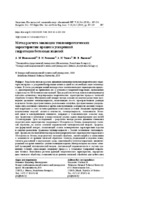Метод расчета эволюции теплоэнергетических характеристик процесса ускоренной гидратации бетонных изделий

Date
2019Publisher
Another Title
The Method of Calculation of the Evolution of Thermal and Energy Characteristics of the Accelerated Hydration Process of Concrete Products
Bibliographic entry
Метод расчета эволюции теплоэнергетических характеристик процесса ускоренной гидратации бетонных изделий = The Method of Calculation of the Evolution of Thermal and Energy Characteristics of the Accelerated Hydration Process of Concrete Products / А. М. Нияковский [и др.] // Энергетика. Известия высших учебных заведений и энергетических объединений СНГ. – 2019. – № 4. – С. 307-324.
Abstract
Разработка методов расчета динамики изменения тепловых энергетических характеристик процесса ускоренной гидратации является одной из сложнейших задач теплоэнергетики. В статье рассмотрен новый метод расчета теплотехнических характеристик процесса, ориентированный на применение его в установках ускоренной гидратации, применяемых в производстве 3D-бетонных конструкций. При разработке метода использованы принципы клеточно-автоматного моделирования энергетических характеристик процесса тепловой обработки бетонов. Математический аппарат метода основан на конечно-разностном трехмерном уравнении теплопроводности, позволяющем учесть: пространственные размеры изделия из бетона, пространственное расположение опалубки, пространственное распределение нагревательных элементов и другие конструктивные особенности системы ускоренной гидратации за счет системы граничных и начальных условий. Входными параметрами используемых моделей являются плотности, теплопроводности, теплоемкости бетонной смеси и конструктивных элементов, входящих в технологическую оснастку изделия. Граничные и начальные условия позволят решать задачи моделирования для любой 3D-конструкции. Цель исследований – разработка метода расчета динамики изменения энергетических характеристик твердеющего 3D-изделия из бетона, подвергнутого тепловой обработке, на основе сеточной неравновесной теплофизической модели. Представлен формульный аппарат, позволяющий связать геометрические характеристики изделия и конечно-разностные уравнения теплопроводности с учетом источников тепловыделений. Предложен численный метод определения энергетических характеристик твердеющего 3D-изделия из бетона, подвергнутого тепловой обработке, заключающийся в вычислении в зависимости от времени тепловой обработки: теплоты, подведенной к изделию извне; теплоты, рассеянной в окружающую среду; выделившейся теплоты гидратации; аккумулированной в изделии теплоты с учетом геометрии изделия. Метод построен на основе сеточной трехмерной теплофизической модели, учитывающей неравновесность и систему граничных условий, отражающих специфику процесса в установках ускоренной гидратации бетонов. Выполнены расчеты функций энергетических характеристик, определяющих тепловую обработку, в зависимости от времени тепловой обработки для кубических 3D-изделий из бетона различного размера. Показано, что скорость изменения энергетических характеристик можно моделировать для изделий любой пространственной конфигурации.
Abstract in another language
The development of methods for calculating the dynamics of the energy thermal characteristics of the accelerated hydration process is one of the most difficult tasks of heat power engineering. The article describes a new method of calculating the thermal characteristics of the process, focused on its application in the installations of accelerated hydration used for the production of 3D-reinforced concrete structures. The principles of cellular-automatic modeling of energy characteristics of concrete heat treatment process were used in the development of the method. The mathematical apparatus used in the method is based on the finite-difference three-dimensional heat equation, which allows taking into account, due to the system of boundary and initial conditions, the spatial dimensions of the concrete product, the spatial arrangement of the formwork, the spatial distribution of heating elements and other design features of the accelerated hydration system. The input parameters of the models used are the density, thermal conductivity, heat capacity of the concrete mixture and structural elements included in the tooling of the product. Boundary and initial conditions will make it possible to solve modeling problems for any 3D-design. The goal of the study is to develop a method for calculating the energy characteristics dynamics of the hardening of 3D-concrete products subjected to heat treatment, based on a grid non-equilibrium thermal model. The paper presents a mathematical equation apparatus that allows linking the geometric characteristics of the product and the finite-difference equations of thermal conductivity, including sources of heat. A numerical method for determining the energy characte- ristics of the hardening of 3D-concrete products subjected to heat treatment has been proposed consisting of, depending on the time of heat treatment, the calculation of the outside heat supplied to the concrete product, heat dissipated into the environment, the emitted heat of hydration and the heat accumulated in the concrete product during heat treatment, taking into account the geometry of the product. The method is based on a grid three-dimensional thermophysical model that takes into account the nonequilibrium and the system of boundary conditions that reflect the specifics of the process in the accelerated hydration of concrete. Calculations of the functions of the energy characteristics determining the heat treatment, depending on the time of heat treatment for cubic 3D-concrete products of different sizes have been performed. It is demonstrated that the rate of alteration of energy characteristics can be modeled for products of any spatial configuration.
View/
Collections
- № 4[6]
